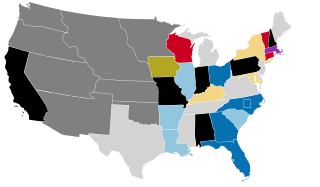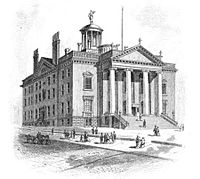Background
Under the provisions of the New York Constitution of 1846, 32 Senators were elected in single-seat senatorial districts for a two-year term, the whole Senate being renewed biennially. The senatorial districts (except those in New York City) were made up of entire counties. 128 Assemblymen were elected in single-seat districts to a one-year term, the whole Assembly being renewed annually. The Assembly districts were made up of entire towns, or city wards, forming a contiguous area, all in the same county. The City and County of New York was divided into four senatorial districts, and 16 Assembly districts.
At this time there were two major political parties: the Democratic Party and the Whig Party.
The Democratic Party was split into two factions: the Hard-Shells (or Hards) and the Soft-Shells (or Softs). In 1848, the Democratic Party had been split into Barnburners and Hunkers. The Barnburners left the party, and ran as the Free Soil Party, with presidential candidate Martin Van Buren. Afterwards the larger part of the Free Soilers re-joined the Democratic Party. During the following years, the Hunkers split over the question of reconciliation with the Barnburners. The Hards were against it, denying the Barnburners to gain influence in the Party. The Softs favored reconciliation with the intention of maintaining enough strength to win the elections. Both Hards and Softs favored a compromise on the slavery question: to maintain the status quo and to leave the decision to the local population in new Territories or States if they want slavery or not, as expressed in the Kansas-Nebraska Act. The Barnburners were against the permission of slavery in new Territories or States, but were now the minority in the party. The small faction of the Free Soil Party which advocated abolition of slavery, ran their own State ticket as the "Free Democratic Party".
About this time the Temperance movement began to enter politics to advocate legal and/or political measures to prohibit the sale of alcoholic beverages, and endorsed candidates of the major parties who favored prohibition.
Sessions
The Legislature met for the regular session at the Old State Capitol in Albany on January 3, 1854; and adjourned on April 17.
Robert H. Pruyn (W) was elected Speaker with 74 votes against 24 for George De Witt Clinton (Hard) and 17 for Jonathan C. Collins (Soft).
On January 20, the Legislature passed "An Act to perfect an amendment of the Constitution, providing means for the completion of the canals of this State".
On January 30, Andrew B. Dickinson (W) was elected president pro tempore of the State Senate.
On February 15, a special election was held at which the Canal Amendment was ratified by the voters with 185,771 votes For; and 60,526 votes Against the proposed amendment. [1]
On April 4, the Legislature elected Victor M. Rice (W) as the first State Superintendent of Public Instruction.

The 1853 New York state election was held on November 8, 1853, to elect the Secretary of State, the State Comptroller, the Attorney General, the State Treasurer, the State Engineer, two Judges of the New York Court of Appeals, a Canal Commissioner, an Inspector of State Prisons and the Clerk of the Court of Appeals, as well as all members of the New York State Assembly and the New York State Senate.

The 1855 United States Senate election in New York was held on February 6, 1855, by the New York State Legislature to elect a U.S. Senator to represent the State of New York in the United States Senate.

The 1854–55 United States Senate elections were held on various dates in various states. As these U.S. Senate elections were prior to the ratification of the Seventeenth Amendment in 1913, senators were chosen by state legislatures. Senators were elected over a wide range of time throughout 1854 and 1855, and a seat may have been filled months late or remained vacant due to legislative deadlock. In these elections, terms were up for the senators in Class 3.

The 67th New York State Legislature, consisting of the New York State Senate and the New York State Assembly, met from January 2 to May 7, 1844, during the second year of William C. Bouck's governorship, in Albany.

The 68th New York State Legislature, consisting of the New York State Senate and the New York State Assembly, met from January 7 to May 14, 1845, during the first year of Silas Wright's governorship, in Albany.

The 69th New York State Legislature, consisting of the New York State Senate and the New York State Assembly, met from January 6 to May 13, 1846, during the second year of Silas Wright's governorship, in Albany.

The 71st New York State Legislature, consisting of the New York State Senate and the New York State Assembly, met from January 4 to April 12, 1848, during the second year of John Young's governorship, in Albany.

The 72nd New York State Legislature, consisting of the New York State Senate and the New York State Assembly, met from January 2 to April 11, 1849, during the first year of Hamilton Fish's governorship, in Albany.

The 73rd New York State Legislature, consisting of the New York State Senate and the New York State Assembly, met from January 1 to April 10, 1850, during the second year of Hamilton Fish's governorship, in Albany.

The 74th New York State Legislature, consisting of the New York State Senate and the New York State Assembly, met from January 7 to July 11, 1851, during the first year of Washington Hunt's governorship, in Albany.

The 75th New York State Legislature, consisting of the New York State Senate and the New York State Assembly, met from January 6 to April 16, 1852, during the second year of Washington Hunt's governorship, in Albany.

The 76th New York State Legislature, consisting of the New York State Senate and the New York State Assembly, met in Albany from January 4 to July 21, 1853, during the first year of Horatio Seymour's governorship.

The 78th New York State Legislature, consisting of the New York State Senate and the New York State Assembly, met from January 2 to April 14, 1855, during the first year of Myron H. Clark's governorship, in Albany.

The 79th New York State Legislature, consisting of the New York State Senate and the New York State Assembly, met from January 1 to April 9, 1856, during the second year of Myron H. Clark's governorship, in Albany.

The 80th New York State Legislature, consisting of the New York State Senate and the New York State Assembly, met from January 6 to April 18, 1857, during the first year of John A. King's governorship, in Albany.

The 83rd New York State Legislature, consisting of the New York State Senate and the New York State Assembly, met from January 3 to April 17, 1860, during the second year of Edwin D. Morgan's governorship, in Albany.

The 84th New York State Legislature, consisting of the New York State Senate and the New York State Assembly, met from January 1 to April 16, 1861, during the third year of Edwin D. Morgan's governorship, in Albany.

The 86th New York State Legislature, consisting of the New York State Senate and the New York State Assembly, met from January 6 to April 25, 1863, during the first year of Horatio Seymour's second tenure as Governor of New York, in Albany.

The 87th New York State Legislature, consisting of the New York State Senate and the New York State Assembly, met from January 5 to April 23, 1864, during the second year of Horatio Seymour's second tenure as Governor of New York, in Albany.

The 88th New York State Legislature, consisting of the New York State Senate and the New York State Assembly, met from January 3 to April 28, 1865, during the first year of Reuben E. Fenton's governorship, in Albany.



